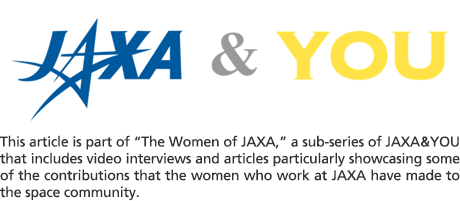
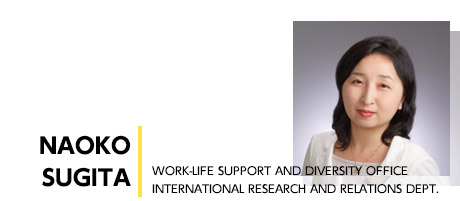
Profile
Ms. Sugita earned her bachelor’s degree from the Tokyo University of Foreign studies in 1993, and then went on to earn a Master of Law from Hitotsubashi University in 1995 and then subsequently a Master in Public Administration at the Harvard Kennedy School in 2002. She ultimately received a doctorate from the National Graduate Institute of Policy Studies in 2010.
In addition to JAXA, she has worked at the Japan Science and Technology Agency, as well as at the Ministry of Education, Culture, Sports, Technology, Science, and Technology. Currently, at JAXA, she is the Advisor to the Director of the International Relations and Research Department, as well as the Deputy Director to the Work-Life Support and Diversity Office.
Interview
So you work both in JAXA‘s Work-Life Support and Diversity Office and in JAXA‘s International Relations and Research Department. Could you tell us a bit about that?
In the International Relations department, I‘m analyzing international trends so that I can support the decisionmaking of JAXA management and the government as well. In the Work-Life Support and Diversity Office, there are two important jobs that I do. One is that I want to change the workstyles of employees so that they become more productive and innovative. The second is that, related to the first responsibility, we try to promote female participation in the workforce and try to ensure that the female workers here can be productive and have a meaningful job here.
I understand in your job that you work a lot with non-Japanese companies and governments. Could you tell us a bit about the challenges of that?
Yes, well of course it’s a challenge to work with people of other countries and different cultural backgrounds but at the same time, that‘s the really fun part of space development. If you look at the history of space development or space activities, they‘ve been promoted by both international cooperation and international competition. I think space activity is really inherently international, as there are many things that a country cannot do on its own so I think that there are the two aspects of cooperation and competition.
For me, it‘s almost very natural to work with people of other countries. Of course it‘s a challenge but for me it‘s always fun to work with people from other countries who are sharing the same objectives and dreams. When I first joined NASDA, the former organization of JAXA, I think it was basically just the United States and European countries, but these days we have more interaction with people from Asian countries as well so it‘s getting more exciting.
You‘re also a part of the Work-Life Support and Diversity Office, and I understand that a lot of companies that are focused on STEM have a lot of difficulties recruiting female employees and keeping them working and pursuing a STEM career. Could you tell me a bit about how your office is trying to tackle that?
So you‘re exactly right that we‘re facing a big challenge in terms of having more female participation in the workforce but we have been the home of female astronauts, researchers, and flight directors, so we do have females working in very important positions. But the problem is that the number is very small, and also that we don‘t have that many people in decisionmaking levels so we identify those as two major challenges that we have to address. We set up numerical targets to have more females in the decisionmaking process and we try to recruit more university students so that they can come to JAXA soon after they finish studying.
Are there some sorts of programs or something that JAXA does? How do you go about that?
Yes, there‘s a public open day held at Tsukuba Space Center and each JAXA center and we try to have an event at that time and come up with female role models in JAXA and they try to be as open as possible about how they work and how they manage their work and their private life. In that way, the female students who might be there may become interested in working in aerospace.
So what originally got you interested in working at an aerospace agency?
First of all, I‘m not an engineer— my background is not science. But I wanted to be a researcher in international relations, but I found out that it really takes time to become a researcher, and I thought that it might be a good experience to work before that. Since I was a small child I have been interested in astronomy and space, but because I did not choose to major in science or those fields I didn‘t think that I‘d have a job in space. But when I was doing my master‘s studying and decided that maybe I should not go to a doctor‘s program but start working, NASDA was looking for people who had a strong background in international relations because at that time the International Space Station program was really going on. I thought that that might be interesting because it‘s what I both studied and what I‘ve been really interested in since I was a small child so that‘s the reason why I chose NASDA.
Since coming to work at JAXA, what has left the largest impression on you and why?
I was fortunate to see the places where they actually manufacture launch vehicles and rockets and satellites both in Japan and countries such as the United States. Seeing those technologies really coming to place and how they‘re being manufactured, it‘s quite interesting— those cutting-edge, state of the art technologies being crafted, sometimes really by people‘s hands, but they become such a complex and large system and go to space. These days I think that I am really interested in how those technologies are made on the ground.
Finally, please give us a message to young girls who are interested in aerospace.
My background is not engineering or science but I‘m involved in space development and it‘s really exciting. It‘s true that there is a very small number of students studying aerospace or STEM but if you‘re interested I really think that it‘s important that you try [it], regardless of whether you don‘t think that you can really do it or not. To be honest, I really worried before I started working whether I would have any professional role here but I‘m enjoying it. There are many things you can do in the area of space so please join! If you‘re interested, yes, we‘re waiting for you!
More on JAXA’s Work-Life Support and Diversity Office
JAXA believes in the importance of supporting gender equality and a happy and healthy work-life balance. As JAXA President Naoki Okumura says, employees cannot give their best at work if they do not have a fulfilling family life. JAXA’s Work-Life Support and Diversity Office promotes the well-being of all of JAXA’s employees through a variety of programs and support systems. For example, JAXA emphasizes the importance of engineers, scientists, researchers, etc. working in teams, which ensures that if one employee enters an important life event, that employee, regardless of gender, may feel more comfortable taking time off. JAXA also emphasizes, via this office, that no employee may receive disadvantageous treatment on the basis that said employee applied for or took a reduction of work hours related to childcare. On a related note, JAXA provides flexible hours for those who need to care for family members, and even built a nursery school at one of its field centers for the young children of JAXA employees and full-time partner employees.

Photo of Hoshinoko [lit: star child] Nursery School located at JAXA’s Tsukuba Space Center
In addition to general support for childcare, the Work-Life Support and Diversity Office also leads programs related to encouraging women into aerospace and other STEM fields. During days that JAXA opens its field centers to the public, in addition to panels regarding JAXA’s technological and scientific advancement, they also hold a series of talks where they showcase the wide range of careers that female employees hold at JAXA, and also discuss work-life balance.
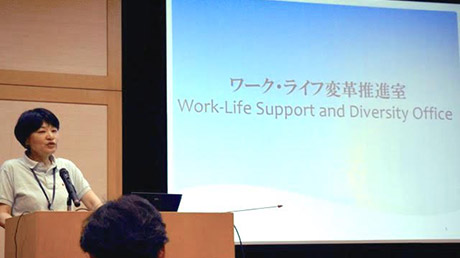
Photo from Sagamihara Open Days in July 2016 of Hiroko Mukai, the Director of the Work-Life Support and Diversity Office.
The Office also shares information on efforts made by other agencies, such as the Japan Science and Technology Agency, to promote STEM-related majors for girls, especially those coordinated with particular universities.
More on JAXA’s International Activities
Though JAXA is based in Japan, its activities stretch beyond Japan’s borders. As a space agency, we very much values international collaboration. Below are two projects that JAXA has worked on recently in collaboration with non-Japanese entities.
The Philippines: DIWATA-1
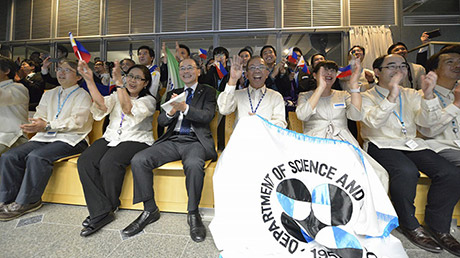
Image taken at JAXA’s Tsukuba Space Center of project staff rejoicing after a successful deployment of DIWATA-1 into orbit from the ISS’s Japanese Experiment Module Kibo in April, 2016.
In April of 2016, JAXA deployed the Philippines’ first microsatellite: DIWATA-1. This satellite was jointly developed by the Department of Science and Technology of the Republic of the Philippines, the University of the Philippines Diliman, Tohoku University (Japan), and Hokkaido University (Japan). Designed to help the Philippines assess infrastructural damage after disasters, DIWATA-1 was deployed into orbit via the International Space Station’s Japanese Experimental Module Kibo in April. According to one of the project officials, this project is also intended to advance the overall ability of the Philippines to develop space.
Satellite-Based Emergency Mapping
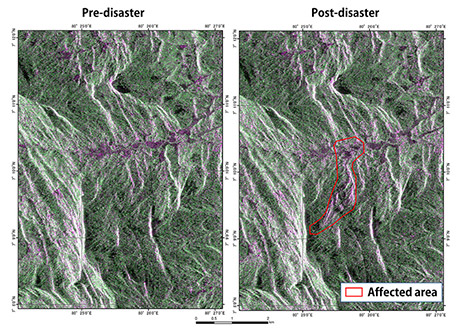
Comparison satellite image taken by JAXA’s Advanced Land Observing Satellite ALOS-2 (Daichi 2) of before and after a landside that occurred due to heavy rains in Sri Lanka
JAXA is a collaborator on a paper released in Science in July 2016 entitled “Global Trends in Satellite-Based Emergency Mapping.” In this paper, researchers analyzed the history of disaster management and tracking via satellite technology, and highlights that it is Europe and Asia that has placed the most effort into using satellites to map the effects of disasters. In particular, JAXA has been involved in mapping the effects of forest fires in Canada, and flooding in both the United States and Sri Lanka.
By Miranda Feliciano Tyson
Edited by Fumika Miyamoto
Publication date: August 29, 2016